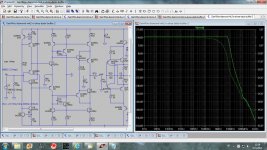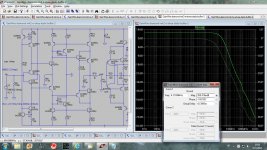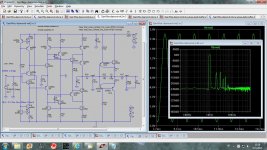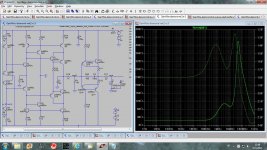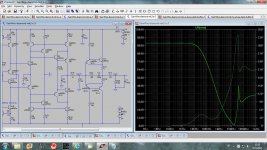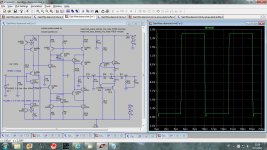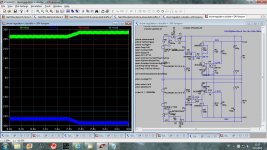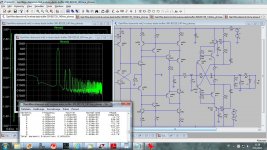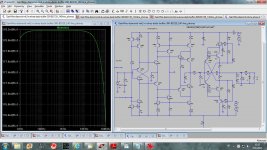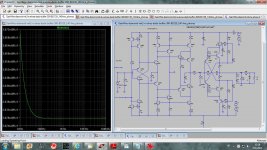Hi Damir,Hi Matthias,
Here is the gain plot without output buffer. First one is without C2 and second with C2.
BR damir
thanks. Cascoding often seems to require some extra tricks. Here in the current mirror, there in the buffer.
Kind regards,
Matthias
Hi Matthias,
Here is the gain plot without output buffer. First one is without C2 and second with C2.
BR damir
I have to wonder whether that peaking is not coming from the current mirrors. All current mirrors have some peaking around the 2-15 Mhz. The EF assisted mirror has much higher peaking than the standard one.
You could try placing small value cap from base to emitter of Q21 and Q22.
Interesting, some performance is lost. Can it be made stable if you remove the zobel and only the RC in place ??
I think it's possible, but I am more interested in simpler output buffer and I will show you what I've found later.
Damir
I have to wonder whether that peaking is not coming from the current mirrors. All current mirrors have some peaking around the 2-15 Mhz. The EF assisted mirror has much higher peaking than the standard one.
You could try placing small value cap from base to emitter of Q21 and Q22.
It helps, the peaking no more, but I don't like the brick wall like plot, and if I keep C2 connected it looks much smoother.
Damir
Attachments
It helps, the peaking no more, but I don't like the brick wall like plot, and if I keep C2 connected it looks much smoother.
Damir
Any of those measures will suffice indeed.
I asked mainly because some have no knowledge about the peaking in current mirrors and this is a very good example of where these anomalies many times originate.
Simpler than diamond buffer ?? I think thats as simple as can be had for such performance.
Any of those measures will suffice indeed.
I asked mainly because some have no knowledge about the peaking in current mirrors and this is a very good example of where these anomalies many times originate.
Simpler than diamond buffer ?? I think thats as simple as can be had for such performance.
Could you take a look at first post in this thread and tell me what you think about that output buffer?
Damir
This is schematic I like the most, with simple output buffer.
THD1k at 2 V output is just 0.000066%
Output impedance is 23 ohm flat from DC up to 100 kHz
I kept output resistor, now lower at 22 ohm, to be less sensitive to the long cable capacitance
PSRR abouth 90 dB
Damir
THD1k at 2 V output is just 0.000066%
Output impedance is 23 ohm flat from DC up to 100 kHz
I kept output resistor, now lower at 22 ohm, to be less sensitive to the long cable capacitance
PSRR abouth 90 dB
Damir
Attachments
This one can drive the headphones from 32ohm(Grado) and up to 300ohm(Sennheiser) with very low distortion(second and third harmonics only).
Damir
are you closer and closer to poweramp with this technique? ;-)
are you closer and closer to poweramp with this technique? ;-)
You are right, I am thinking haw to do that. There are some power amp of similar kind but with to high distortion.
This is simulated THD20k with 300 ohm load(SENNHEISER phones) and THD20k with 32 ohm load(GRADO phones). I don't have time before autumn to make working prototype, that is pity as it should be excellent preamp and no need for exotic components just BC550/560 and BD139/140(or KSA1381/KSC3503 or BF470/471) transistors.
Attachments
Member
Joined 2009
Paid Member
No comments on this simple output buffer?
It would be more interesting (to this forum at least) to see power amp version 🙂
It would be more interesting (to this forum at least) to see power amp version 🙂
I am trying, I am trying. It's easy to make the gain part but output buffer is hard nut. If EF2 or triple is used with no feedback there to much distortion(to my taste). I tried diamond buffer with a triple EF ans still to much THD. I am thinking now to try a buffer with NF(only from output of the buffer to the buffer input). Any suggestion??
I am trying, I am trying. It's easy to make the gain part but output buffer is hard nut. If EF2 or triple is used with no feedback there to much distortion(to my taste). I tried diamond buffer with a triple EF ans still to much THD. I am thinking now to try a buffer with NF(only from output of the buffer to the buffer input). Any suggestion??
What about a Cordel feed forward error correction type..??
What about a Cordel feed forward error correction type..??
Yes I was thinking about that one too, or maybe this from Edmond http://www.diyaudio.com/forums/solid-state/202684-class-i-siblings.html
- Status
- Not open for further replies.
- Home
- Amplifiers
- Solid State
- No NFB line amp (GainWire mk2)
